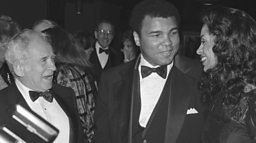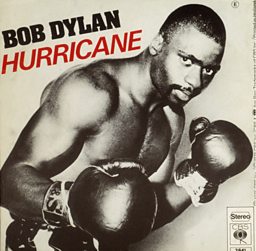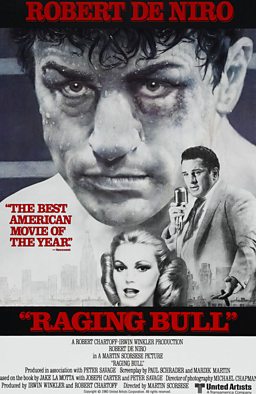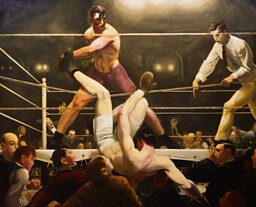Creative knockout: Five amazing works inspired by boxers
6 March 2018
With muscular bodies locked in a physical struggle, it's understandable that artists have long been drawn to boxers. In Civilisations: How Do We Look? Mary Beard examines Boxer at Rest, a bronze sculpture cast in Greece over 2,000 years ago and finds evidence of a fierce intelligence behind the work. But the Greeks weren't the only culture fascinated with pugilists.

What a bruised boxer tells us about ancient art
Mary Beard explores images of the human body in ancient art.
There are a whole host of artistic genres that weren't available to the ancient Greeks. How did filmmakers, painters, writers, songwriters and photographers tell the stories of boxers in the 20th Century?
Photo: Muhammad Ali v Cleveland Williams

It’s unquestionably the best picture I’ve ever taken.Neil Leifer
Given that Muhammad Ali is referred to as The Greatest, it's fitting that he's also the subject of arguably the greatest sport photo ever.
The overhead shot, taken in November 1966 by Neil Leifer, shows Ali with his arms aloft while his vanquished opponent, Cleveland Williams, lies flat out on the canvas.
The idea for this shot began a year before, with an overhead picture he took during Ali's fight with Sonny Liston in Maine.
Leifer said: "Houston Astrodome offered the possibility of having the camera 80 feet over the ring, and because of that I was able to take what I consider to be the best picture of my entire career.
"The funny thing about that picture is it’s not the final knockout. You could never take a picture like that nowadays because the canvas is always coloured and is covered with advertising and TV network info. It’s the only picture I’ve ever shot that I wouldn’t change anything about."
Book: The Fight by Norman Mailer
Then comes the left jab again. A converted southpaw? It has something of the shift of locus which comes from making love to a brunette when she is wearing a blond wig.The Fight
It wasn't just the camera that was drawn to Muhammad Ali, writers sought him out too.
When Ali and George Foreman travelled to Kinshasa, Zaire in 1974 for a multi-million dollar fight organised by promoter Don King, it wasn't just sports journalists who went to cover the event.
Norman Mailer, the writer best known for World War Two novel The Naked and the Dead, also went with the press pack to see The Rumble in the Jungle at first hand.
Given that Mailer was infamous for possessing the streetwise attitude of a prize fighter and no stranger to violence, it was unsurprising that he was drawn towards the highly-publicised clash between two of the world's best boxers.
His experiences in Zaire were recorded The Fight, a book hailed by the New York Times as "a sensitive portrait of an extraordinary athlete and man, and a pugilistic drama fully as exciting as the reality on which it is based."

Kinshasa knockout
-
![]()
Muhammad Ali: The Rumble in the Jungle
Mike Costello relives the fight along with three world champions.
-
![]()
Leon Gast on Muhammed Ali
The director of When We Were Kings recalls what it was like to work with the boxer.
Song: The Hurricane by Bob Dylan
The lives of boxers outside of the ring can often attract as much attention as their exploits within it.
Here's the story of the Hurricane / The man the authorities came to blameBob Dylan
Rubin 'Hurricane' Carter was a professional boxer who was charged, along with his friend John Artis, with the murder of three people in New Jersey in 1966. They denied the charges and believed them to be racially motivated – Carter and Artis were black, the victims were white.
While in jail Carter wrote an autobiography and sent copies to a number of celebrities, including Bob Dylan.
Dylan visited Carter in jail and was inspired to write a song about his case, The Hurricane. He said: "I realised that [Carter's] philosophy and my philosophy were running down the same road."
The lyrics for the song are an extremely detailed account of the case – it runs to eight minutes in length. They were so in-depth that the lawyers at his record label, Columbia Records, asked Dylan to make slight changes to avoid possible lawsuits.
Dylan also staged gigs for Carter with his Rolling Thunder Revue, with the Madison Square Garden concert in 1975 raising $100,000 for the boxer's legal fund.
But it wasn't until 1985 that Carter was permanently freed when a federal judge, Judge H Lee Sarokin, overturned his conviction, declaring that it had been "predicated on an appeal to racism rather than reason, and concealment rather than disclosure".

Carter: Cause célèbre
-
![]()
The story of the Hurricane
Including Mike Costello's interview with Rubin Carter from 1993
-
![]()
Rolling Thunder Revue
Intimate photos from when Bob Dylan gathered a motley crew of friends, musicians and lovers
Film: Raging Bull by Martin Scorsese
I remember those cheers / They still ring in my ears / After years, they remain in my thoughts. / Go to one night / I took off my robe, and what'd I do? I forgot to wear shorts. / I recall every fall / Every hook, every jabJake La Motta in Raging Bull
On the surface, Ray LaMotta's life was perfect fodder for a movie.
A former world middleweight boxing champion, he once threw a fight at the behest of the mob and turned to stand-up comedy after he retired.
Yet his 1970 memoir, Raging Bull, in which he described himself as an emotional fighter struggling with life outside the ring, didn't initially appeal to director Martin Scorsese.
In fact, it took significant effort from Scorsese's friend Robert De Niro to persaude him that the book had the potential to be a great film.
It was a period of ill health that changed Scorsese's mind. "I couldn’t understand Bob’s obsession with it, until, finally, I went through that rough period of my own."
In hindsight, of course, it turned out to be one of the best creative decisions of his career. Raging Bull would earn De Niro the Best Actor award at the Oscars in 1981, as well as a best editing prize for the legendary Thelma Schoonmaker.
Raging Bull remains one of the most critically lauded films of all time, ranking as the American Film Institute's number one film about sport. The Guardian critic Peter Bradshaw, hails it as his favourite film of all time.
He wrote: "The fight sequences themselves, with the camera swirling and swooping around the ring, and the soundtrack sometimes gulping out into silence and sometimes moaning with weird half-heard animal noises, are unforgettable: an inspired reportage recreation in the manner of a Life magazine shoot, which also looks like expressionist newsreel footage of a bad dream."

The man and the movie
-
![]()
The story of Raging Bull
5 live sport celebrate Martin Scorsese's masterpiece.
Painting: Dempsey and Firpo by George Bellows

You could smell the sweat and cigar smoke and feel the heat coming off the crowd.Allen Barra on Dempsey and Firpo
George Bellows was an American artist belonging to what was known as the Aschcan school. The group were known for a uniquely American take on beauty, violence and velocity of the modern world.
Bellows produced a range of boxing images from 1907 to 1924 and was sent by the Saturday Evening Post to cover the fight between US champion Jack Dempsey and Argentinean challenger Luis Firpo.
While the fight lasted less than four minutes, there was no shortage of action – Firpo was on the canvas nine times and Dempsey twice, including being knocked out of the ring as is depicted in the picture.
Allen Barra, a sportswriter for the Wall Street Journal and The Atlantic, is a big admirer of how the painting captures the atmosphere of a boxing match from this era.
He said: "You got all the details and a vivid account of the action that was at the centre of the narrative. You could smell the sweat and cigar smoke and feel the heat coming off the crowd."
The Art of Sport
-
![]()
Tennis reads
Eight titles with a tennis twist to enjoy this summer.
-
![]()
Beautiful game
Creating amazing art through the prism of football.
-
![]()
Creative knockout
Five amazing works inspired by boxers.
-
![]()
Be-spoke creations
Five ways cycling has collided with the world of the arts.
Read more about Civilisations
-
![]()
Civilisations Festival: Delve deeper into the landmark series
Live events and digital innovation - there's much more to get your teeth into courtesy of the Civilisations Festival
-
![]()
"Useless" art: Why did a prehistoric artist make this sculpture?
If our priorities would've been finding food and shelter. why spend hundreds of hours making a 'Lion Man'?
-
![]()
The price of civilisation: Would you die for art?
Who are the people willing to risk their lives for art?
-
![]()
Mary Beard: Why a new understanding of 'civilisation' matters
Civilisations presenter Mary Beard discusses what sets the series apart from the original.












